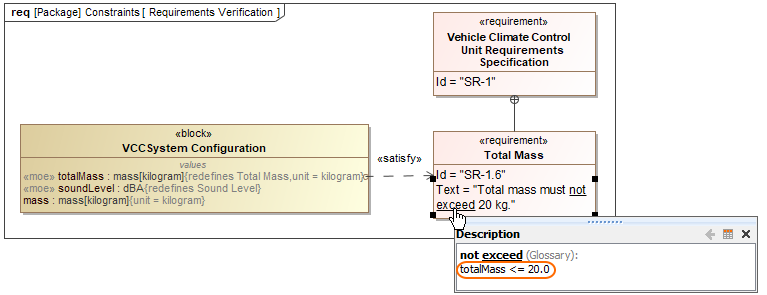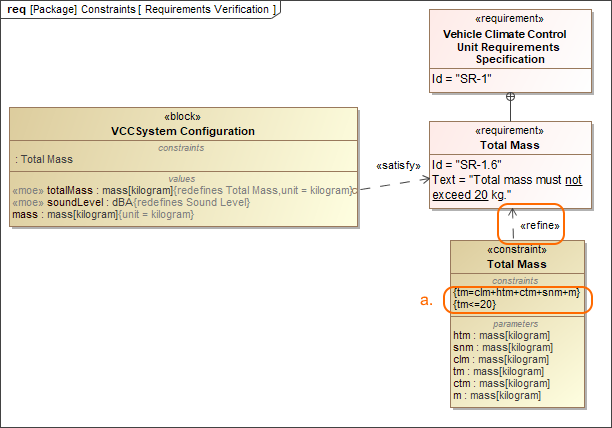On this page
Systems Modeling Language (SysML) is used to capture systems design as descriptive and analytical system models, which relate text requirements to the design and provide a baseline to support analysis and verification. Having the system parameter calculated, you can verify the system requirement and give the verdict on whether it is satisfied or not. The modeling tool enables to perform this verification automatically.
Getting ready for automated requirements verification
Before performing the automatic Requirements verification you need to get ready for this.
To get ready for automated requirements verification
- Define the constraint in Requirement text.
Draw a Satisfy relationship from the Value Property to the Requirement.
The Value Property captures the system parameter whose value determines whether the system requirement is satisfied or not.
Do one of the following:
If the Use Requirement Term Glossary option is enabled, the condition pattern in the Requirement text is underlined. Move the mouse pointer over it to see the expression in the tooltip. If it is correct, you are ready to perform the automatic Requirement verification.
- If the expression in the tooltip is not correct, do the following:
- Perform either of the two options:
- Right-click a value property in the compartment area of the element shape.
- Right-click the Requirement.
- Select Tools > Extract Constraint Block From Requirement to automatically create a Constraint Block.
- You can modify the constraint expression and the parameters as needed (see Figure A below).
- Perform either of the two options:
You are now ready to perform the automatic Requirement verification.
In the example above, a Constraint Block with the constraint {totalMass <= 20} and the constraint parameters is automatically created. The constraint expression is then modified to {tm=clm+html+ctm+snm+m}{tm<=20}.
Performing automated requirements verification
With a help of simulation, you can perform automatic Requirements verification.
To perform the automatic Requirements verification you must have the Cameo Simulation Toolkit installed. How to install >>
To perform automatic Requirements verification
- Right-click the Block which contains Value Property.
- From the shortcut menu, select Simulation > Run.
In the Question dialog, click Yes to load the validation rules and validate the model before the simulation or No to simulate the model without validating it.
- In the Simulation window, click or press F8 to start simulation.
The result if value is satisfied or not is shown in the Variables pane. In the following figure, you can see when the Requirement is not satisfied (highlighted in red) and satisfied (highlighted in green). You can change the value directly in the Value cell and Requirement constraint is checked automatically.
Additional features of Cameo Simulation Toolkit



